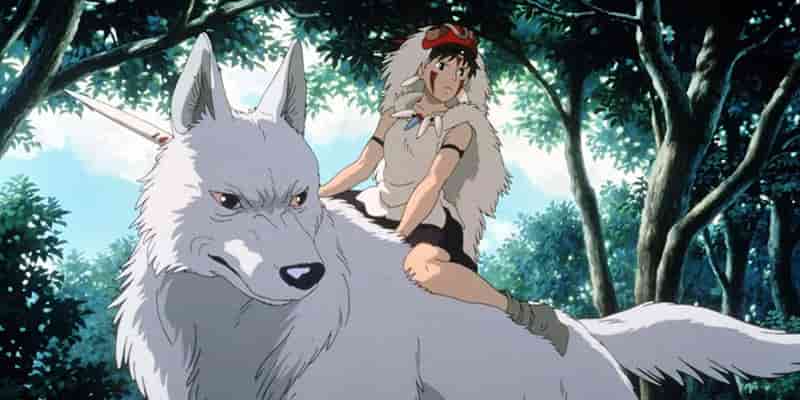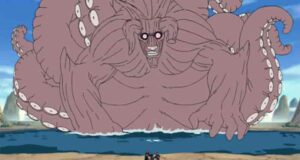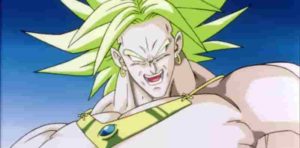In 1997, Studio Ghibli and director Hayao Miyazaki released the epic, supernatural story Princess Mononoke. Pulling from familiar Japanese folklore, mythology and Shintoism, Miyazaki creates his own fairy tale with stunning animation and giant wolf gods. These wolves are crucial to the crux of the story, serving as soldiers and messengers of the Great Forest Spirit.
As the movie progresses, we are introduced to many different spirits of nature. These spirits include giant boars, two-tailed wolf gods, small wood sprites, strange, red-eyed apes and The Great Forest Spirit, a dear-like creature during the day and giant, ephemeral “nightwalker” by night. Mankind is clearing their home to build Iron Town, using explosives and firearms to protect themselves and generate commerce.
This conflict evolves until we meet our two heroes, Prince Ashitaka and “Princess” Mononoke. Prince Ashitaka is exiled from his home by a curse. However, Mononoke is a human girl raised by giant wolf spirits. The heroes fall somewhere between humanity and nature and become tools to restore balance. In a way, Mononoke herself is an extension of the will of the wolves. Then, the will of the wolves matches the will of the forest.
The Story of Human Heroes and Forest Spirits
The story revolves around the last Emishi prince, Ashitaka, who encounters a curse that exiles him from his home. We already connect this young man to nature because of his unique friend, a “red elk” he rides like a horse. Myazaki wastes no time showing us this character’s heroic attributes—he’s brave, bold and cunning.
In an attempt to stop a worm-infested demon (the worms a common symbol of poison in Japanese folklore), his arm is “infected” with the same curse. He finds that this “demon” he slayed is actually the boar god Nago and the curse developed from an iron ball lodged inside of the deity.
As monstrous as this foe appeared, it was merely an entity in pain, a pain caused by humans.
Shintoism and Kami
Nature and mankind’s materialism tend to be major aspects of Miyazaki’s films, an aspect that holds the philosophy of Japanese Shintoism. With Princess Mononoke in particular, Miyazaki pulls from this ancient tradition, along with Japanese folklore
Though Japan is largely non-religious, the practice of Shintoism is still a relevant part of life within the country. The basis is of this religion is the belief in the interconnected nature of the environment. Nature itself is a collection of interconnected spirits, or kami.
Yorishiro is a Japanese word for a place where a spirit dwells, such as a tree, object or natural location. This is the place where kami dwell, a living force within seemingly inanimate objects, a concept known as the divine fabric of reality. Within Miyazaki’s fairy tale, it appears that forest itself is a great yorishiro, one that houses many kami. The conflict comes from humanity’s need to grow and develop land, destroying the home of these ancient spirits.
Iron Town and its inhabitants aren’t inherently evil–they’re just trying to get on with their lives. The real evil is created through unchecked fear and hate—the spirits fearing human steel and fire and the humans fearing the mysterious forest.
Related Posts:
Naruto: References to Eastern Mythologies
| Samurai Champloo: Who is the Sunflower Samurai?
|
The Wolf Gods
The wolf goddess Moro and her pack raise the young San (Princess Mononoke) to essentially be a wolf. Her movements are feral, impressive and nearly inhuman. Her knowledge of the forest and primal experience directly save Prince Ashitaka. However, she 100% believes she is a wolf. In a way, she is out of touch with her humanity. Fortunately, she experiences growth toward her humanity as the story progresses.
As opposed to the boar gods, the wolves come in fewer numbers. Only one pack appears, led by Morro. The wolves are similar in appearance to the Okami spirit of Japanese folklore, which were often guardians, guides and messengers of the mountain gods. These white wolves show up in many different forms across Japanese mythology. However, the visits can be not so friendly.
Miyazaki blends this mythological Japanese wolf with another Japanese classic, the many-tailed fox. Moro, the mother, is shown to have two tails, a symbol of her divine essence and age. As the story goes, multiple-tailed animals, such as foxes, are thought to be mystical, shapeshifting beings of folklore. The tails grow over the ages, combining as many as 9 tails.
However, Miyazaki isn’t giving an exact translation of the folklore, just borrowing the concept for his fairy tale. Therefore, she is recreated from related lore to signal that she’s the boss. Plus, this dominance adds an element of motherhood toward Mononoke.
The Great Forest Spirit
Also known as Shishigami and nightwalker, this is probably one of Miyazaki’s most original creations.
This forest spirit is wild to behold. It is designed as a deer-like entity with a human-like face, bird-like feet and antlers that resemble tree branches. On top of this mysterious creature design, he transforms into something even more bizarre as the giant nightwalker. So, what was the inspiration for such an awe-inspiring entity?
Firstly, using deer makes sense for the base design. This creature resembles the legendary Kirin. At first, he’s simply foraging with a group of Japanese sika deer. Then, he turns his head to look at the audience and we realize there is Wisdom in this creature. His antlers are intricate and enormous, portrayed like the limbs of an old tree. This embodies a connection with the plant life as well, the forest itself. As he walks, life generates beneath his feet—flowers, grasses, vines. Therefore, he proves that he is to be revered. In fact, he’s so jam-packed with life-creating magic that the emperor believes his head will bring him immortality. Thus, a major conflict of the forest’s ultimate fate is at stake in the climax of the movie.
As the Forest Spirit is further threatened, he transforms into his giant Night-Walker form. As best as my research could tell, the nightwalker is loosely connected with a yokai named Daidarabotchi. However, this yokai is only vaguely similar to what Miyazaki created—merely connected to mountain creation. The walking chimera in Princess Mononoke is more animalistic in appearance, made with an ethereal, fluid substance. Honestly, Miyazaki’s version was one of the most captivating characters in the story.
The Ultimate Fate of the Forest Spirits
Finally, the end of Princess Mononoke is bitter-sweet as the Forest Spirit sacrifices itself to heal the land. We’re emotionally connected to this healing because it heals Prince Ashitaka as well. The forest will never be the same. It won’t be the mysterious home of ancient spirits like it used to be. Now, we’ll just have to be satisfied that nature is restored.
In a sad sort of way, the people who remain must say goodbye to the beauty that was once there. However, this forces us to gain perspective as the viewer. To appreciate the beauty in the world while it exists and accept that it may end. Bittersweet endings always seem to have the strongest sense of closure. Plus, I leave the viewing experience with something to think about.
Related Posts:
| Top 7 Most Iconic 90s Sci Fi Anime | Dragon Ball Z: Why Broly Hates Goku
|




